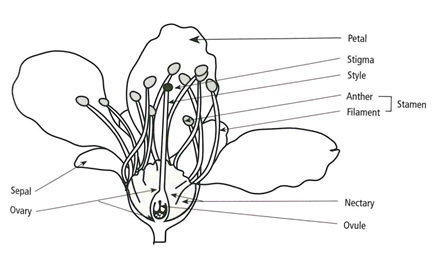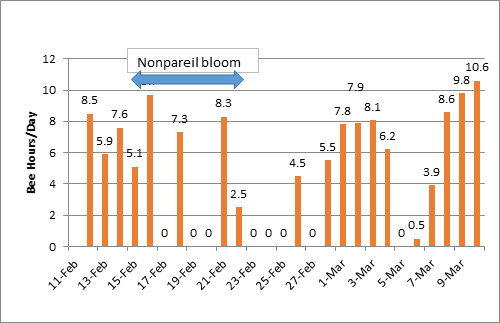Predicting nut set in any given year is often a bit difficult. A review of the many steps involved in successful nut set may provide a better understanding of just what went wrong (or right) for different varieties across the region at bloom.
- Anthers (see Fig. 1 below) open as relative humidity drops in the late morning, exposing dry pollen grains (containing male sperm cells). Not all anthers in a flower open on the same day, so fresh pollen is produced by the same flower for several days. Rain can rupture pollen grains after anthers open and before pollen grains germinate. Temperature does not affect pollen viability, but it does influence pollen germination and pollen tube growth rate.
 Figure 1. Drawing of a ‘Mission’ variety almond flower.
Figure 1. Drawing of a ‘Mission’ variety almond flower.- Bees move pollen from the anthers of one flower to the stigma of a compatible variety’s flower. Bees are more active when temperatures are above 55oF, winds are less than 15 mph and it is not raining. When these conditions are met for an hour, we count that as a “bee hour” – a rough metric of good or bad conditions for pollination. See the daily bee hours graph (Fig. 2) from one location in the Sacramento Valley in 2017. Strong hives (8 frames or more) collect 3x more pollen than a 4 frame hive.

Figure 2. Daily “bee hours” at Nickels Soil Lab, Arbuckle, CA (Colusa County). 2017. A “bee hour” is an hour in during which temperatures are above 55oF, winds are less than 15 mph and it is not raining.
- Stigma (the pollen landing pad) and style (the passageway to the ovule, see Fig. 1 above) are receptive for 4-5 days. If the stigma is receptive, the pollen grain hydrates from stigmatic secretions, germinates and begins to grow down the style towards the ovule, which contains female germ cells. If the pollen tube reaches and enters the ovule while the ovule is still viable, a nut will be set. Multiple pollen tubes grow down the style simultaneously preparing the ovule for fertilization, but only one pollen tube’s contents fertilize the ovule. Multiple pollen tubes growing down a single style, including both compatible and incompatible pollens will improve the chances for successful fertilization of the ovule.
- Rate of pollen germination and pollen tube growth towards the ovule is temperature sensitive. At temperatures between 50-70oF, pollen grains germinate rapidly. Optimum pollen tube growth rate occurs between 60-85o
- Pollen tube growth from germination to ovule fertilization can take 5-8 days, depending on temperature. An ovule remains viable for 5-7 days. The effective pollination period is the time “window” between flower opening and the last day a pollen grain can land on the stigma and still grow down the style to fertilize a viable ovule.
- The sooner after opening a flower is pollinated, the better the chances that it will set a nut. In UC research, flowers pollinated on the day they opened had 30% nut set, flowers pollinated 3 days after opening had 21% set, and flowers pollinated 5 days after opening had only a 1% chance of setting a nut. This is why it is so important to have viable, compatible pollen in the orchard (and good bee activity) when Nonpareil flowers begin to open. This is also why it is good that all flowers don’t open on the same day.


Leave a Reply